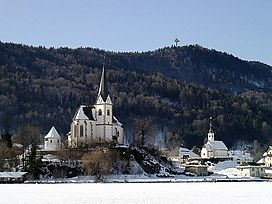geo.wikisort.org - Mountains
Pyramidenkogel is an 851-metre-high (2,792 ft) mountain in Carinthia, Austria. It is located to the south of the Wörthersee and near the town of Maria Wörth, in an area that is a boundary between speakers of German and Slovenian.[1] In nearby Slovenia the mountain is known as Jedvovca. The mountain has been a tourist attraction since at least the late 19th century. The view from its top is mentioned in Karl Baedeker's 1879 The Eastern Alps.[2]
| Pyramidenkogel | |
|---|---|
 View of the Pyramidenkogel from Maria Wörth | |
| Highest point | |
| Elevation | 851 m (2,792 ft) |
| Isolation | 4.7 km (2.9 mi) |
| Coordinates | 46°36′32″N 14°08′43″E |
| Geography | |
| Location | Carinthia, Austria |
Another mountain named Pyramidenkogel can be found in Austrian Totes Gebirge mountain range. Located south-east of the Almsee, its height is 1961 m.
Structures on the mountain

First structure and cross
A wooden observation platform had been built in 1950, as was a cross to remember the dead of World War I and World War II and "victims of the mountains." The cross was consecrated on 20 August 1950. An annual "Trausteinmesse," a special Mass, is celebrated at the end of summer.[3]
First Pyramidekogel Tower (1968-2012)
A 54-metre-tall (177 ft) observation and broadcasting tower of steel and concrete, the Pyramidenkogel Tower,[4] was built between 1966 and 1968 and was a well-known "futuristic" tourist attraction, according to the Rough Guide to Austria;[5] Lonely Planet calls it "avant-garde."[6] In 2008, the last summer season before construction of a new edifice, the tower welcomed the five-millionth visitor. The tower was eventually demolished on October 12, 2012.[7]
Current Tower (2013-Present)
In July 2006, plans were made to tear down the existing tower and replace it with a new building, a multi-purpose activity centre,[8][9] which was approved in 2007[10] and for which the Carinthian government set aside €10 million in 2008.[11] A competition for the new design was started in 2007;[12] the architectural firm of Klaura & Kaden won the competition. Construction was to have begun by late 2008,[13] and the old tower was to be imploded in October 2008, but was postponed and financial and political difficulties prevented any new construction. The demolition was planned once again for September 2010 but was postponed again. The last opening day was on September 30, 2012, and the first existing tower was demolished on October 12, 2012.[8][14]
The new tower, finished in 2013, was described by Dietmar Kaden as a "Himmelsleiter aus gestapelten Ellipsen," a ladder into heaven made of stacked ellipses, and is to function as a "Leuchtturm der Holzbranche," a lighthouse for the timber industry.[15][16] No name has been decided on; Markus Klaura has proposed "Isis Noreia," for the goddesses Isis and Noreia (the latter a Germanic deity, the Roman equivalent of Isis).[13]
The new tower is built of wood and steel, and at a height of 100 metres it is the tallest wooden observation tower in the world.[17][18] Architects Markus Klaura and Dietmar Kaden of Klagenfurt and structural engineer Markus Lackner of Villach have designed a structure which features a visitors platform at 83 metres, a cafe at 70 metres, and a 66-metre-long (217 ft) slide (the longest slide in Europe[19]). The tower is PEFC-certified.[20]
- The demolished Pyramidenkogel Tower, built in 1968
- View from the new tower toward the northeast. The lake Wörthersee and Maria Wörth peninsula are clearly visible. Klagenfurt is at right.
- Detail of the tower's wood-steel construction
See also
List of towers
References
- Suppan, Arnold (1996). Jugoslawien und Österreich 1918-1938: bilaterale Aussenpolitik im europäischen Umfeld. Oldenbourg Wissenschaftsverlag. p. 473. ISBN 978-3-486-56166-1.
- "Magnificent view of the Dachstein, Todte Gebirge, and the Traunsee and Laudach lakes, lying immediately below." Baedeker, Karl (1879). The eastern Alps, including the Bavarian highlands, the Tyrol, Salzkammergut, Styria, and Carinthia: handbook for travellers. Leipzig: Karl Baedeker. p. 88.
- "Traunsee: Traunsteinmesse unterm Heimkehrerkreuz". Im Salzkammergut. 2008-09-06. Retrieved 2009-04-24.[permanent dead link]
- "Pyramidenkogel Tower". Structurae. Retrieved 2009-04-23.
- Bousfield, Jonathan; Rob Humphreys; Kev Reynolds (2001). The Rough Guide to Austria. Rough Guides. p. 332. ISBN 978-1-85828-709-6.
- Haywood, Anthony; Kerry Walker (2008). Austria. Lonely Planet. p. 297. ISBN 978-1-74104-670-0.
- "Die fünfmillionste Besucherin". Kleine Zeitung. 2008-10-01. Retrieved 2009-04-24.
- "Grünes Licht für den Pyramidenkogel". Kleine Zeitung (in German). 2009-03-23. Retrieved 2009-04-23.
- "Aussichtsturm am Pyramidenkogel über dem Wörther See wird abgerissen: 2009 soll neuer Turm samt Erlebniszentrum stehen". Der Standard (in German). 2007-01-28. Retrieved 2009-04-23.
- "Neues Wahrzeichen für Kärnten". Österreich Journal. 2007-07-02. Retrieved 2009-04-24.
- "LR Dobernig: Wir sind der Garant für die Konjunkturbelebung in Kärnten!". Der Standard. 2008-11-26. Retrieved 2009-04-23.
- "Wettbewerb für Pyramidenkogel in Endphase". Kleine Zeitung. 2007-06-29. Retrieved 2009-04-23.
- "Neuer Pyramidenkogelturm soll in der Landschaft tanzen". Österreich Journal. 2007-08-24. Retrieved 2009-04-24.
- "Turm wird heuer nicht gesprengt". Kleine Zeitung (in German). 2008-10-10. Retrieved 2009-04-23.
- Strauß, Florian (2008-01-28). "Zukunft des Holzbaus: Gemeinsames Gestalten ist gefordert". Timber online. Retrieved 2009-04-23.
- Zöscher, Hans (2008-04-14). "Forstlicher Informationstag des Kärntner Forstvereines: Erfolgreiche Tätigkeit durch Bildungsoffensive". St. Hubertus online. Retrieved 2009-04-24.
- "Kärnten bekommt höchsten hölzernen Aussichtsturm der Welt". Kleine Zeitung (in German). 2008-07-02. Retrieved 2009-04-24.
- Strauß, Florian (2008-01-28). "Große Hallen, hoher Turm: Vorstellung von Holzbau-Projekten in Alpbach". Timber online. Retrieved 2009-04-23.
- "Der Himmelsstürmer will noch viel höher hinaus". Kleine Zeitung (in German). 2007-12-17. Retrieved 2009-04-24.
- "World's Highest Wooden Observation Tower is PEFC Certified". PEFC. 2013-06-20. Retrieved 2015-06-11.
External links
- "Pyramidenkogel Panoramic Tower". SkyscraperPage.
- Video animation of the new wooden tower
На других языках
[de] Pyramidenkogel
Der Pyramidenkogel (slowenisch Jedvovca) ist ein 850 m ü. A. hoher Berg in Südkärnten, Österreich.[1]- [en] Pyramidenkogel
[it] Pyramidenkogel
Il Pyramidenkogel (in sloveno: Jedvovca) è una montagna di 850 m s.l.m. situata nella Carinzia meridionale, in Austria.Другой контент может иметь иную лицензию. Перед использованием материалов сайта WikiSort.org внимательно изучите правила лицензирования конкретных элементов наполнения сайта.
WikiSort.org - проект по пересортировке и дополнению контента Википедии



